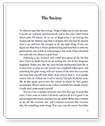Essay Instructions: The assignment is divided into two parts. (Each of which is 600-800 words) Basically 1200-1600 words total for both.
Part 1: Encompasses 3 activities, with a combined word count of 600-800 words
Characteristics of Scholarly Writing
Format: Short Answer
Word Count: 600-800 words in total (for the three activities)
Bloom’s Taxonomy and Constructing an Essay Plan
In the 1950's Bloom and colleagues, who were educational psychologists, developed a way to categorise the degree of abstraction required of people when answering questions. Within this cognitive domain, Bloom developed six categories ranging from 'knowledge' to 'evaluation'. Importantly, in Bloom’s proposed taxonomy, each category builds upon previous categories such that more is required of a person asked to 'evaluate' evidence than when they are simply asked to 'describe' the evidence. At university we most often expect you to evaluate (or critique) evidence. Therefore, it is necessary for you to know: 1) what is expected of you intellectually when you are asked to 'evaluate' the evidence; and 2) how to improve your essay writing to demonstrate this high level of abstraction. The following two activities are designed to further your understanding of the process. Before attempting them, familiarize yourself with the following article, reproduced in the ‘Readings for Assignment 1’ section of this Assignment Guide:
Granello, D. H. (2001). Promoting cognitive complexity in graduate written work: Using Bloom's taxonomy as a pedagogical tool to improve literature reviews. Counsellor Education and Supervision, 40, 292-307.
Activity 1
In Assignment 2 (Section A) you will be asked to write an essay on one of three possible topics. For the current activity, choose one of those essay topics.
Essay Topic:
Biological Psychology
Is marijuana a dangerous drug?
In your essay you may wish to consider:
• The molecular events through which marijuana acts
• Changes to the brain and behaviour as a result of marijuana use
• Medicinal uses of marijuana
Having chosen an essay topic, use the information in Granello (2001) to outline how you will go about the writing process to produce an essay that is consistent with Bloom's 'evaluation' category. The focus of your response should be on the general principles of essay construction at the evaluation level (i.e., summarising the information in Granello, 2001). However, you will get the most out of this activity by using your chosen essay topic to provide specific examples of how you will apply the general principles discussed in your own essay. You do not need an extensive knowledge of your chosen topic to do this.
Activity 2
Construct a brief essay plan for your chosen topic, which demonstrates the evaluative essay principles you discussed in response to Activity 1. The plan can be dot pointed (in fact this is encouraged) and should fit easily onto a single A4 page.
Distinguishing Between Scholarly and Nonscholarly Writing ??" Note: I don’t mind which pair is chosen.
When researching an essay question it is important to read widely, but to reference only scholarly publications. To help you determine what makes writing scholarly we have prepared four pairs of articles for you:
First pair
(a) Too sexy for the job ??" at the top, that is.
(b) Perceptions of power: First impressions of a woman wearing a jacket.
Second pair
(a) Ladies who lotto: The ranks of female gamblers are growing.
(b) Not the same: A comparison of female and male clients seeking treatment from problem gambling counselling services.
Third pair
(a) The attractiveness factor
(b) Attitudes and perceptions of workers to sexual harassment.
Fourth pair
(a) Beware beer goggles.
(b) Effects of alcohol on person perception: A social cognitive neuroscience approach.
(Note: All of these articles will be uploaded)
Each pair above consists of an article from a daily newspaper or magazine (an example of non-scholarly writing) and a corresponding article from a peer-reviewed journal (an example of scholarly writing). The term ‘peer-reviewed’ refers to the fact that these articles go through a rigorous screening process before being accepted for publication. The process involves a review of the article by two or more independent (and anonymous) researchers, qualified in the area, who provide feedback on the quality of the experiments and theoretical propositions discussed within. An article will only be published in a peer-reviewed journal if it receives a favourable assessment from the reviewers. Therefore, an article will often need to be revised on the basis of the reviewer feedback before being acceptable for publication. This maximises the accuracy of the information provided.
Activity 3
Choose one of the article pairs listed above then compare and contrast the two pieces of writing for:
1. Purpose
2. Intended audience
3. Structure
4. Depth of knowledge
5. Accuracy of information presented
6. The use of citations/references
7. The ability to present alternative perspectives
Having completed this activity you should be aware of what constitutes scholarly writing when you go to choose readings for your essay (Assignment 2).
Part 2: Application of Learning Theory
Format: Short answer
Word Count: 600-800 words
The first two sections of Assignment 1 introduced you to principles of ‘information communication’. This section of the assignment addresses another skill that is just as important: applying the accumulated knowledge to a practical ‘real world’ situation. Below you will find two scenarios, whereby the fundamental learning theories of classical or operant conditioning can be applied. Choose ONE of the scenarios to write up as directed. Note: I don't mind which.
Scenario 1
A colleague from New York once described the problems they had trying to rehabilitate users of ‘crack’ (a derivative of cocaine). Users were taken from the South Bronx area, a highly urbanised and poor location, to the surrounding countryside for rehabilitation. The users were largely able to stop using crack and to maintain their abstinence while in the countryside environment. However, once the bus transporting them away from the rehabilitation centre crossed the Hudson River and neared home, many of the ex-users reported extreme cravings and most relapsed within 48 hours. Provide a classical conditioning explanation for why a stay in the countryside permitted abstinence and why the mere sight of familiar surroundings prompted drug cravings and relapses in these individuals. In your answer you may also like to discuss the link between this phenomenon and other observations such as drug tolerance and overdose. Note: To answer this question it would be helpful to have a basic knowledge of classical conditioning, which you can obtain from the Learning section of the Unit Study Guide plus the associated reading. The question also requires you to think beyond this initial information. The following reference has been included in the ‘Readings for Assignment 1’ to help extend your understanding in this area.
Siegel, S., & Ramos, B.M.C. (2002). Applying laboratory research: Drug anticipation and the treatment of drug addiction. Experimental and Clinical Psychopharmacology, 10, 162-183.
Scenario 2
Sometimes inappropriate behaviour can be acquired through behavioural condition. Discuss how a child’s tantrums might be learnt through operant conditioning. How could operant principles be used to bring about more appropriate behaviour? What other behaviours can be modified through operant conditioning and how? Discuss principles of reinforcement and punishment in your response.
I have extensive pdf's for everything so the independent research required is minimal.
There are faxes for this order.


